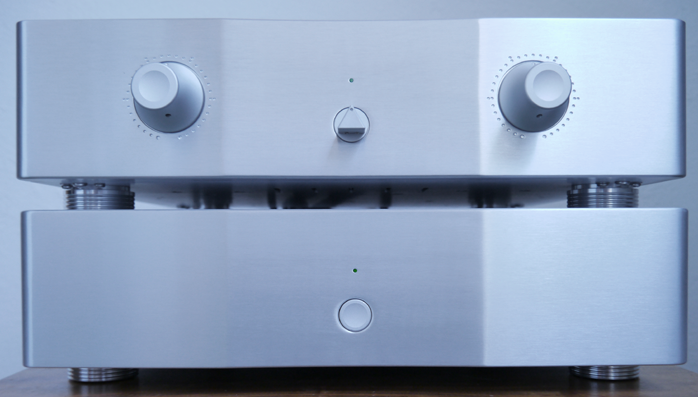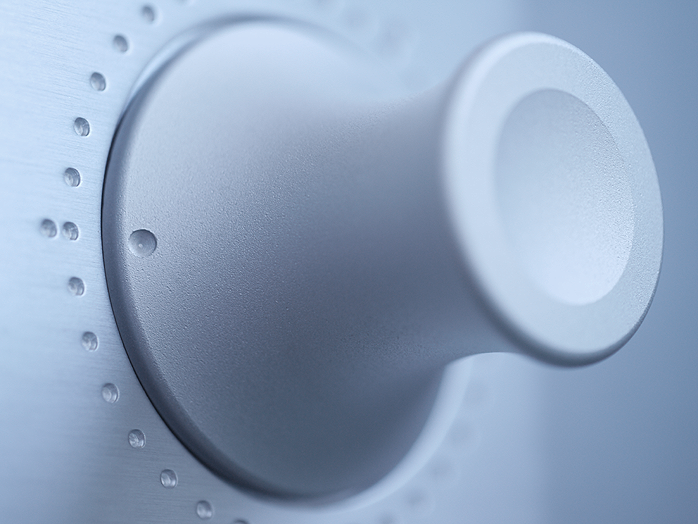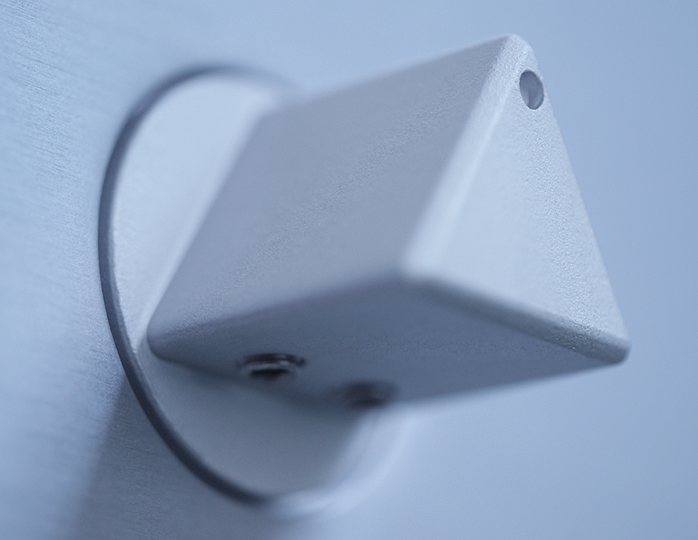This review page is supported in part by the sponsors whose ad banners are displayed below |
 |
 |
Wired up to the Goldmund Job 225 stereo amp with 35dB of gain, I drove Boenicke Audio's B-10 speakers off my usual Metrum Hex converter preceded by SOtM's best two-box battery-powered super-clocked USB bridge. The first thing I noticed was gain. Or rather, insufficient attenuation at click one. At the whisper levels I use during late-night workouts, I needed an extra 6dB signal cut. This I sourced through PureMusic's 64-bit dithered digital option. Hence with a high-gain amp coupled to speakers, listening distance and room size of sufficient 'efficiency' against very low playback levels, max attenuation might not be max enough. Granted, 26dB gain amps are rather more common than my 35dB job. For many this may be no issue particularly if they never listen very quietly. Aside from the functional limitations described on the previous pages, exactly where the attenuation taper came on thus was my only other personal gripe. It wasn't too fast or skippy in its progression. For me it simply didn't kick in soon enough. I could have used two more clicks between mute and where it started.
|
 |
The first sonic surprise was just how loud the R-T1 sounded at micro volumes. We're all familiar with hifi's mandate that escalating volumes ought to only go louder, not change with band-specific compression, stridency, brightness, hardness or other nonlinearities. Hardly anyone talks about the inverse. Things shouldn't collapse, shrink or disappear as volumes fade. It's probably a fortuitous combo of current drive, overall system resolution and speaker responsiveness that delays the inevitable sonic shrinkage which accompanies counter clockwise on the dial. Old-fashioned loudness controls were meant to compensate for HF/LF loss at pianissimo levels but none of today's high-end gear has them. Here the R-T1 set a new high in low. It maintained truly phenomenal intelligibility and substance all the way down into the very ambient noise floor of the room itself.
|
 |
If you think on it, there's something very wrong with being held hostage by systems which only satisfy when played loud. Sometimes loud isn't appropriate or possible. Sometimes you're not in the mood for it. Should you settle for a lesser experience then or, worse, opt to not listen at all? If you relate, the Audio Music preamp up-ends such silliness (obviously your particular amp/speaker interface must be capable of transferring massive signal cut into proper fullness and detail - and many speakers just aren't). Very likely Fang's magnetic volume controls had something to do with this due to how effective their lot get as one turns them down. The upshot is that contrary to popular lore where tube circuits are inherently noisier than transistor equivalents to come second on resolving power, on low-down intelligibility with body the R-T1 thoroughly whupped ass on my Esoteric C-03 preamp and even outweighed my Nagra Jazz in the bass.
|
|
|
This segues straight to our core appeal today. Usually mass is the enemy of transparency. Load up on mass, go lighter on see-throughness. Increase lucidity and watch weightiness fade. One of the balancing acts anyone actively involved in assembling a hifi system must walk is deciding where exactly on this scale to be.
With the R-T1 in the loop one gets to move up on both weight and lucidity in lockstep. That's not normal but very productive and beneficial. The effect is quite akin to printing out a color drawing in speed mode with spent cartridges particularly the black one versus selecting superior slow mode with fresh colors. The former will be faded and pale, its lines inconsistent. The latter will show maximal contrast with fully saturated lines and extreme legibility. Resolution and impressiveness—how the lines impress/imprint themselves on your senses—go up. And that's exactly how the R-T1 asserts itself. It handles resolution not by emphasizing transients or sharpening outlines. To coin a term related to dynamic contrast, it manages heightened resolution with material contrast as the difference between space that's empty and space that's taken up by seemingly material substance.
|
 |
This makes for a different flavor of presence. It's not constructed on the basis of perfectly timed accelerated transients and the dynamic frisson and jump factor derived from it. It's not primarily about the transmission of energy then. It's an equally tacit but different sort of presence. To borrow from Starship Enterprise's transporter beam, it's built on beamed-downness completed with a few extra moments on the molecular reassembler. It's quite uncanny and light years removed from common tube gear dialogue on harmonic distortion and temporal flexibility. None of that factors. In those terms it's a perfectly realized transistor sound albeit with very uncommon material contrast. With my reference Nagra—whose remote response, volume taper and zero-gain option combine into the ultimate user interface—I'd call the qualities to register first space followed by textural elegance. This doesn't mean you hear more or less. At this level it's only about a different perceptional perspective, not about the contents of what one perceives. The contents are fully realized in either case. The musicians play all the same notes.
|
 |
This 'all there' of course included my magnetic passive Tap X from Bent Audio which played up the lucid aspect. At very low volumes meanwhile the resistor-based Khozmo passive with remote clearly shrunk, faded and paled to act inarguably subtractive by comparison. Even at regular levels that passive couldn't muster the same profoundly substantial conviction of the Audio Music. Whilst otherwise sharing TVC technology, the Bent too came second here to perhaps demonstrate the active circuit's trump card in the robustness stakes.
|
|
|
To my mind there was no doubt. Fang's reference ambitions weren't egoic talk or aloof navel gazing but plain fact. On sonics and build if not features the R-T1 was true reference caliber. This makes the £4.250 asking price for EU shoppers quite a deal. Chinese origins and popular yellow fever don't factor. Nor do tubes per se or 'pedestrian' Russian stockers in particular. If we apply popular expectations the 6H30/6922 combination sums to solid state but categorically eliminates the minor glare and dryness the 6H30 routinely exhibits on its own. You'd be hard-pressed though to generate this level of nothing-to-something contrast with transistors. The use of valves thus doesn't seem frivolous or accidental. As the offset between empty silent space and dense tone fill those bottles do something, just not what most might expect.
|
 |
With my Goldmund Job 225 amp, many have wondered. Is the relative lightness of its power supply related directly to the amp's lucidity and speed? Such thinking suggests that an overkill power supply could lead to ponderousness. In Audio Music's apparently overkill case I heard none of the latter if we exempt bass. It wasn't slow but ultra butch. Nagra's PSU for the Jazz would fit into Fang's casing 10 times or more. It could seem like an underdeveloped joke but the sound is anything but. As a matter of fact the Jazz played it more lit up, impulsive and quick. In the end and purely on aural feel we might say that if you prefer Yo-Yo Ma go Jazz, if Mstislav Rostropovich think R-T1.
|
 |
Conclusion. The R-T1 should be of particular interest to people of either hi-eff systems where deep attenuation is the order of the day; or those who routinely listen quietly but presently belabour a significant loss of substance whenever they do. Here the transformer-based volume controls excel at maximizing drive at very low signal voltages. It really was just a matter of time. Reference Chi-Fi has arrived. Audio Music's R-T1 TVC valve preamp belongs into the top echelon of performance as do its assembly and finish quality. It might take a few more years for this new reality to sink in. The few adventurous souls open-minded enough to already give this machine an audition should simply agree that this future is here now!... |
|
 |
 |
|
|
 |